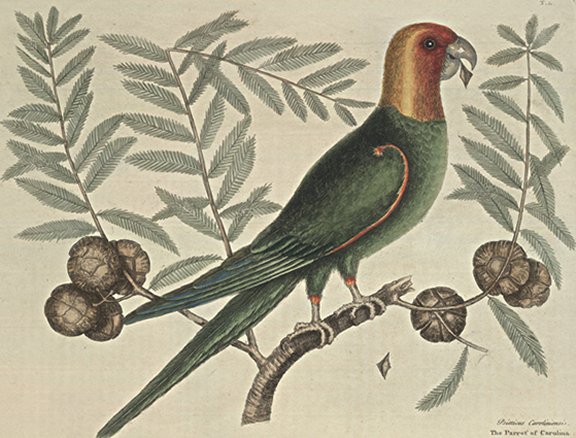Plate Number: I 11Psitticus Caroliniensis: The Parrot of Carolina This Bird is of the bigness, or rather less than a Black-bird, weighing three ounces and an half: the fore-part of the Head Orange-colour; the hind-part of the Head and Neck yellow. All the rest of the Bird appears green; but upon nearer crutiny the interior vanes of most of the wing-feathers are dark-brown: the upper-parts of the exterior vanes of the larger Wing or Quill-feathers, are yellow, proceeding gradually deeper colour'd to the end, from yellow to green, and from green to blue: the edge of the Shoulder of the Wing, for about three inches down, is bright Orange-colour. The Wings are very long, as is the Tail; having the two middle-feathers longer than the others by an inch and half, and end in a point; the rest are gradually shorter. The Legs and Feet are white: the small Feather covering the Thighs, are green, ending at the Knees with a verge of Orange-colour. They feed on Seeds and Kernels of fruit; particularly those of Cypress and Apples. The Orchards in Autumn are visited by numerous flights of them; where they make great destruction for their Kernels only: for the same purpose they frequent Virginia; which is the furthest North I ever heard they have been seen. Their Guts are certain and speedy poison to Cats. This is the only one of the Parrot kind in Carolina: some of them breed in the Country; but most of 'em retire more South. The CYPRESS of AmericaThe Cypress (except the Tulip-tree) is the tallest and largest in these parts of the world. Near the ground some of 'em measure 30 foot in circumference, rising pyramidally six foot, where it is about two thirds less; from which to the limbs, which is usually 60 or 70 foot, it grows in like proportion of other trees. Four or five foot round this Tree (in a singular manner) rise many Stumps, some a little above ground, and others from one to four foot high, of various shape and size, their tops round, cover'd with a smooth red Bark. These Stumps shoot from the roots of the Tree, yet they produce neither Leaf nor Branch, the Tree increasing only by seed, which in form are like the common Cypress and contain a balsamic consistence of a fragrant smell. The Timber this Tree affords, is excellent, and particularly for covering Houses with, it being light, of a free Grain, and resisting the Injuries of the weather better than any other here. It is an Aquatic, and usually grows from one, five and six foot deep in water; which secure situation seems to invite a great number of different Birds to breed in its lofty branches; amongst which this Parrot delights to make its Nest, and in October, (at which Time the Seed is ripe) to feed on their Kernels. |